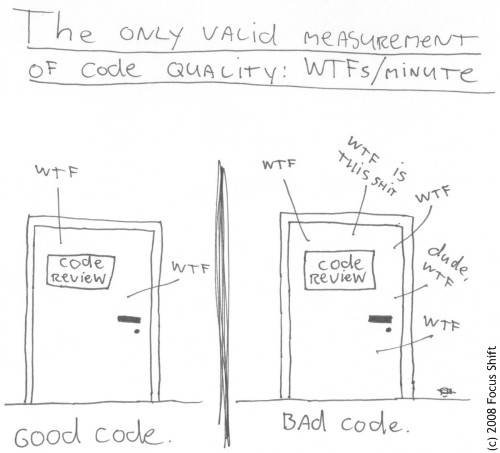Practical Clean Code
BarcelonaJS - 2018-10-22
Israel Saeta Pérez (@dukebody)
TravelPerk
mission:
manage complexity



projects delay/failure
sneaky bugs
developer suffering & quit
contagious mess
What is clean code
- reads like prose
- makes it hard for bugs to hide
- can be enhanced by a developer other than its original author
- provides one obvious way to make things
1. the prose-programming process
- Step away from your keyboard
- Write the logic you want to implement in
a paper - Write for non-technical users
- Use multiple different levels of detail until you get to something you believe you can implement
- Implement each different piece of logic as a separate function
can a person buy beer?
a person can buy beer if it is at least 18 years old
to compute the age of a person from its birthdate
take the difference from current year and its birthdate year
remove one if its birthday has not yet passed this year
the birthday of a person has passed if the month of its birthday is larger or equal to current month, and the day of its birthday is larger or equal that the current day
can a person buy beer?
function canBuyBeer(person) {
return person.age >= 18;
}
class Person:
get age() {
const birthdate = this.birthdate;
const now = Date();
const year_diff = now.getFullYear() - birthdate.getFullYear();
if (this.hasAnniversaryPassed(now, birthdate)) {
return year_diff;
} else {
return year_diff - 1;
}
}
function hasAnniversaryPassed(now, anniversary) {
return now.getMonth() >= anniversary.getMonth()
&& now.getDate() > anniversary.getDate();
}2. use meaningful variable and function names
- Avoid too short names in general (<= 2 chars)
- Avoid too generic names like stuff, tmp, list, do, process, etc.
- Take into account the variable/function scope
- If it is difficult to name, it might be a bad idea
// bad
let ret = [];
for (const l of legs) {
const s = l.getFirstSegment();
ret.push(s);
}
return ret;
// better
let firstSegments = []
for (const leg of legs) {
const segment = leg.getFirstSegment();
firstSegments.push(segment);
}
return firstSegments;
// bad, too generic variable names
function getPopularity() {
let popularity = {}
allPopularity = db.open("popularity_db.csv")
for (aLine of allPopularity) {
let tmp = aLine.split("\t")
if (tmp.length === 2) {
popularity[tmp[0]] = int(tmp[1].trim())
}
}
return popularity
}
// better
function getPopularityByAirport() {
let popularities = {}
popularityDB = db.open("popularity_db.csv")
for (line of popularityDB) {
let values = line.split("\t")
let correctLine = values.length === 2
if (correctLine) {
airportCode = values[0]
airportPopularity = parseInt(values[1].trim())
popularities[airportCode] = airportPopularity
}
}
return popularities
}3. break long nested functions into smaller ones
reduce cognitive complexity

detect duplicate trips
Given a trip, its duplicates are those from the same company that have the same signature
// bad
function getDuplicatedTrips(trip) {
// calculate signature for trip
let signature = '';
for (const leg of trip.legs) {
for (const segment of leg.segments) {
signature += getSignature(segment);
}
}
// get trips candidate for being duplicate
const company = trip.company;
const candidateTrips = db.trips.filter(company=company);
// calculate signature for each trip
let candidateSignatures = [];
for (const candidateTrip of candidateTrips) {
let candidateSignature = '';
for (const leg of candidateTrip.legs) {
for (const segment of leg.segments) {
candidateSignature += getSignature(segment);
}
}
candidateSignatures.push(candidateSignature);
}
// get the trips for which the signature matches
let duplicatedTrips = [];
for (let i = 0; i < candidateSignatures.length; i++) {
let candidateSignature = candidateSingatures[i];
if (candidatSsignature === signature) {
duplicatedTrips.push(candidateTrips[i]);
}
}
return duplicatedTrips;
}DETECT duplicated trips
// better
function getDuplicatedTrips(trip) {
const signature = getTripSignature(trip);
const candidateTrips = getCandidateTrips(trip);
return candidateTrips.filter(trip => getTripSignature(trip) === signature);
}
function getTripSignature(trip) {
let signature = '';
for (const leg of trip.legs) {
for (const segment of leg.segments) {
signature += getSignature(segment);
}
}
return signature;
}
function getCandidateTrips(trip) {
const company = trip.company;
return db.trips.filter(company=company);
}DETECT duplicated trips
COMPUTE TOTAL INVOICE AMOUNTS FOR MONTH
Get all invoices for the given month and add up their amounts
// bad
function get_total_invoice_amounts(year, month) {
// get inovices for given month
const start = Date(year, month, 1);
const next_month = month != 12 ? month + 1 : 1;
const end = Date(year, next_month, 1);
const invoices = db.invoices.filter({
created_at__gte: start,
created_at__lte: end
});
// sum amounts for invoices
let total = 0;
for (const invoice of invoices) {
for (const item of invoice.items) {
total += item.amount;
}
}
return total;
}
Compute total invoice amounts for month
// better
function get_total_invoice_amounts(year, month) {
invoices = get_invoices_for_month(year, month);
amounts = invoices.map(invoice => get_amount(invoice));
return sum(amounts);
}
function get_invoices_for_month(year, month) {
const start = Date(year, month, 1);
const next_month = month !== 12 ? month + 1 : 1;
const end = Date(year, next_month, 1);
return db.invoices.filter({ created_at__gte: start, created_at__lte: end });
}
function get_amount(invoice) {
// should be internal to class invoice
const amounts = invoice.items.map(item => item.amount);
return sum(amounts);
}
function sum(elements) {
return elements.reduce((element_1, element_2) => element_1 + element_2, 0);
}
Compute total invoice amounts for month
clarify conditionals
// OK
if (['create', 'update', 'delete'].includes(action)) {
check_permission(user, 'write')
}
// better
is_write_action = ['create', 'update', 'delete'].includes(action)
if (is_write_action) {
check_permission(user, 'write')
}
// even better
function is_write_action(action) {
return ['create', 'update', 'delete'].includes(action)
}
if (is_write_action(action)) {
check_permission(user, 'write')
}4. hide details safely
with abstraction and encapsulation
abstraction
Manage complexity by separating the (public) object interfaces from their (hidden) implementation details
encapsulation
Bind together data and operations, allowing only operation through certain methods to prevent misuse


Instead of accessing objects attributes directly, create business methods and use only those, transferring defensiveness from the caller to the callee
// bad
// caller needs to know internals
for (const leg of dog.legs) {
leg.move(10)
}
// better
dog.move(10)
class Dog {
move(forward) {
for (const leg of self.legs) {
leg.move(forward)
}
}
}ask dog move forward
(hide internal structure)

// bad
function getTotalInvoicesAmount(invoices) {
let total = 0
for (const invoice of invoices) {
// exposes internal structure!
for (const item in invoice.items) {
total += item.amount
}
}
return total
}
// better
class Invoice {
get amount() {
return sum(this.items.map(item => item.amount))
}
}
function getTotalInvoicesAmount(invoices) {
let total = 0
for (const invoice of invoices) {
total += invoice.amount
}
return total
}hide internal structure
// bad
function pay(product, wallet) {
// touches internal data!
wallet.money -= product.price
}
// better
function pay(product, wallet) {
wallet.take(product.price)
}
class Wallet {
take(price) {
if price > this.money:
throw Error('Not enough money')
// ...
}
}avoid impossible states
(negative money amount)
// risky
const price = {
'amount': 13,
'currency': 'EUR'
}
// better
class Price {
constructor(amount, currency):
if (this.amount < 0) {
throw Error('Amount cannot be smaller than zero')
}
this.amount = amount
if (!ALLOWED_CURRENCIES.includes(currency)) {
throw Error(`Unknown currency ${currency}`)
}
this.currency = currency
}
}
const price = new Price(13, 'EUR')avoid impossible states
(negative amount, invlaid currency)
6. start simple and do continous refactoring
- Avoid premature flexibility or features because You Arent Gonna Need It
- Keep the design short and simple (KISS)
- Avoid premature abstraction: duplication is far better than the worng abstraction (wait for three examples)
- Easy to refactor to add features later if needed
- Scout rule: Always leave code cleaner than you found it
References

